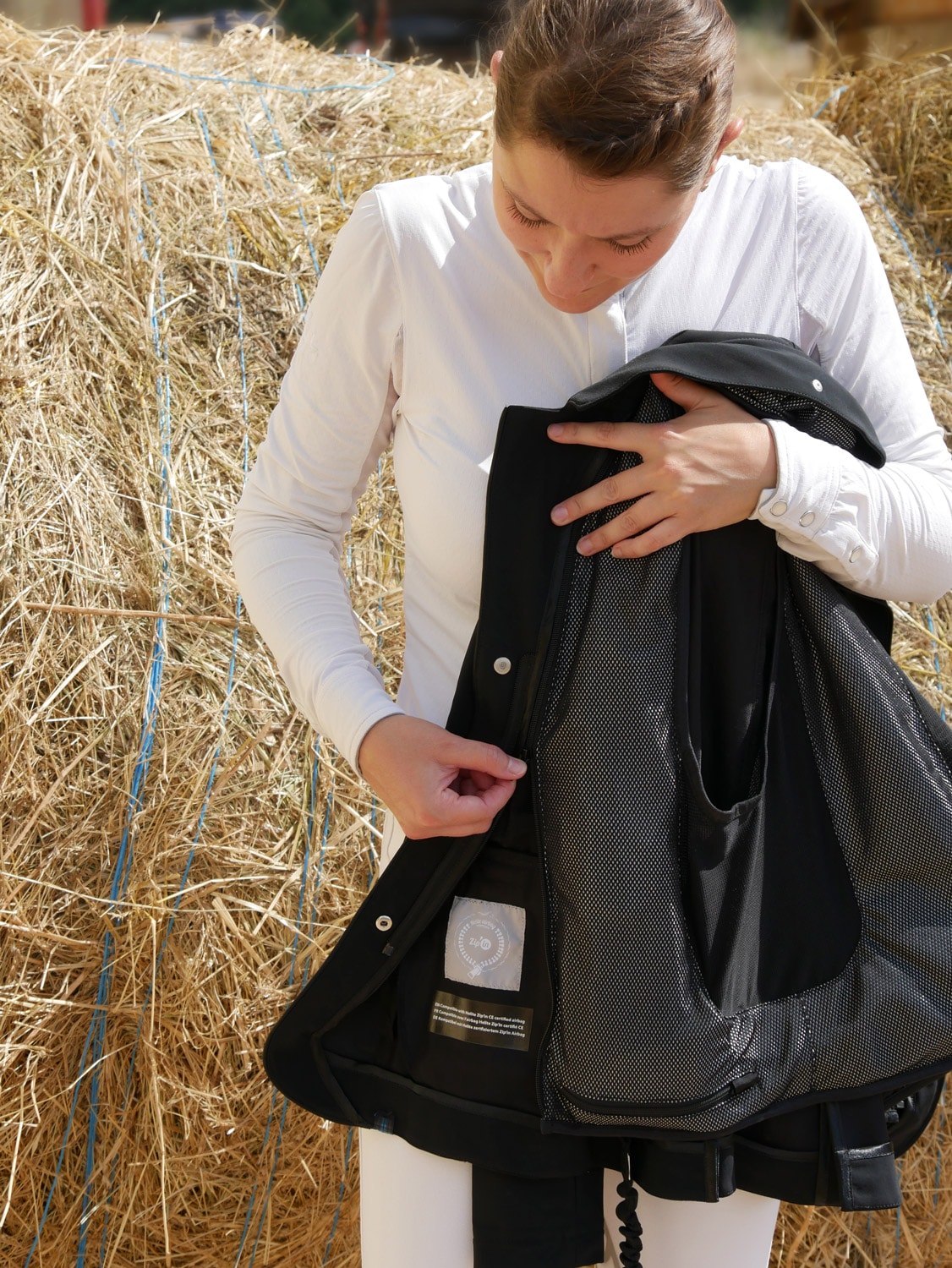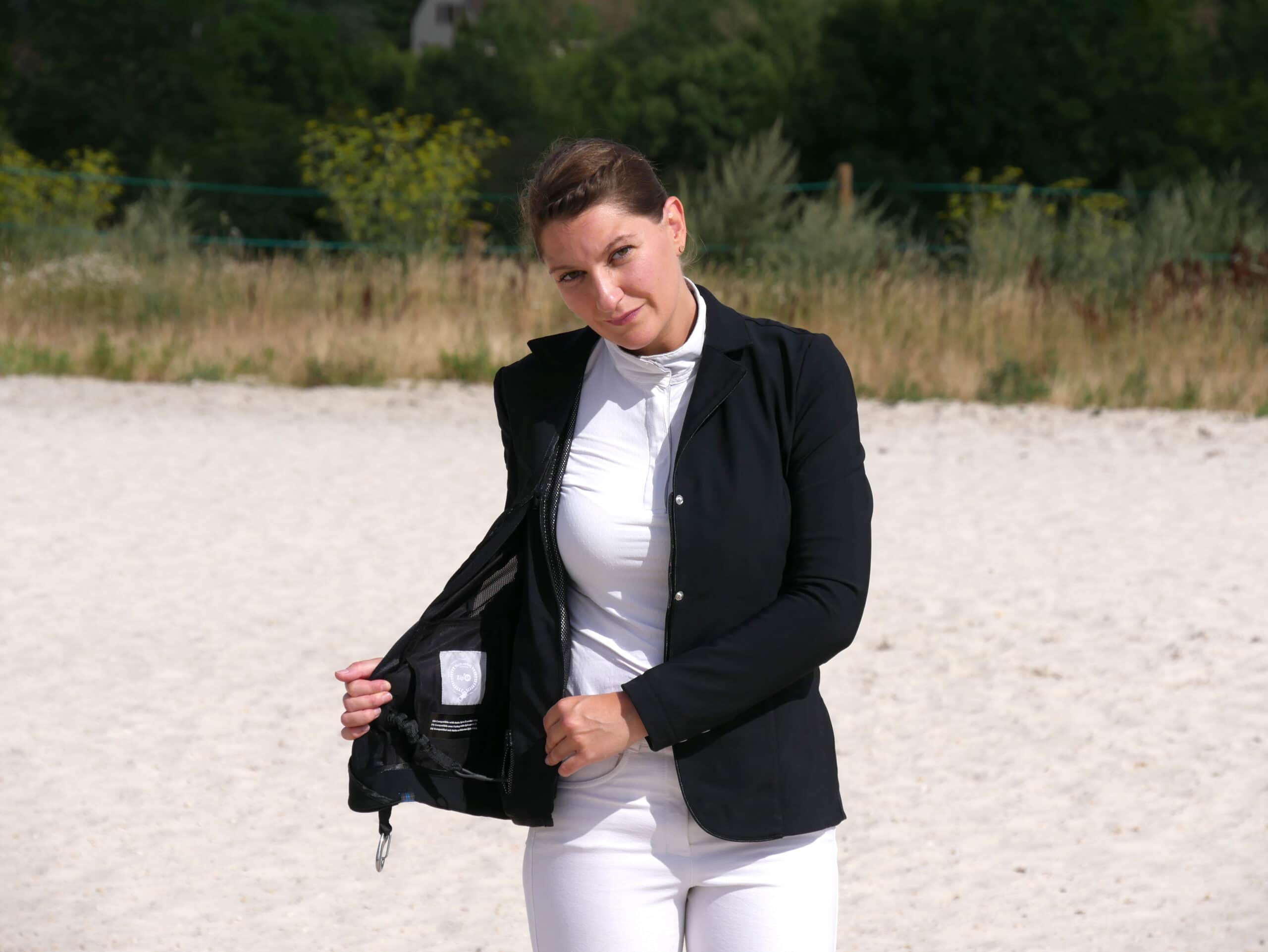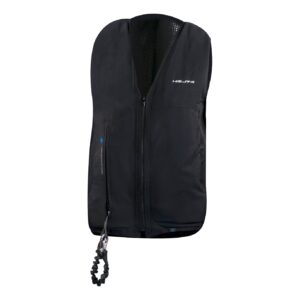KEY FEATURES
- Discreet: the Helite CO2 canister and key ball lanyard are ingeniously concealed.
- Comfort: Soft collar for enhanced comfort when riding.
- Freedom of movement: Elasticated, breathable fabric ensures a perfect fit and freedom of movement.
- Pockets: 2 Exterior zipped, piped pockets.
- Elegant Design: Decorative buttons at the cuffs, satin bias, slit in back, and piped finishes.
- Technical Fabric: Water repellent, breathable and windproof softshell material.
- Resistant: seams resistant to inflation.
- Composition: 58% Polyamide, 19% Elastane, 17% Polyester and 6% Polyurethane.
- Range of sizes available:
- Child L (50cc compatible)
- XS, S, M, L (50cc or 60cc dependant on Zip’In airbag used).
- XL (60cc or 85cc dependant on Zip’In airbag used).
- 2XL (85cc or 100cc compatible dependant on Zip’In airbag used).
PROTECTION
AIRBAG PROTECTION
Big protection volume: the big protection volume (between 14 and 28 L depending on the size of the airbag) prevents serious injuries. The unique shape of the jacket allows the separately supplied airbag to absorb shocks and stabilise the body from head to tailbone.
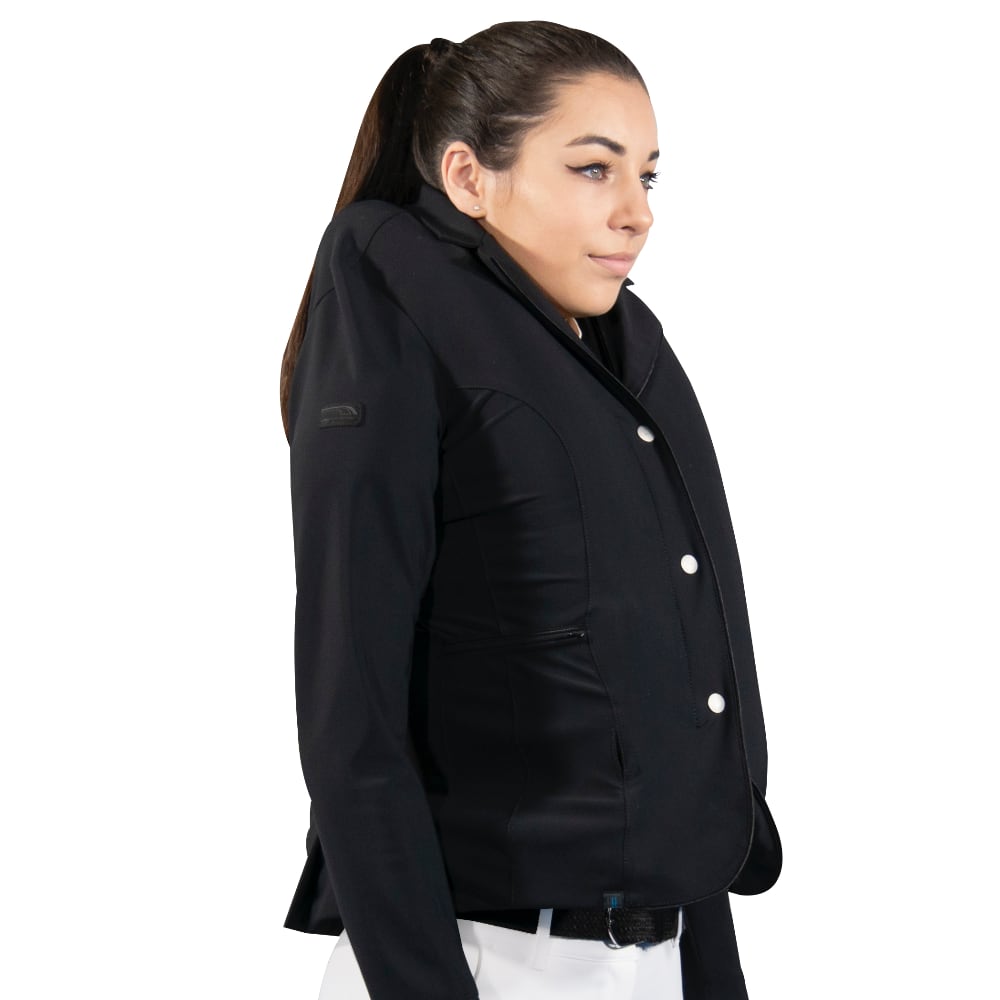
TRIGGER SYSTEM
Zip’In Airvest required. Sold separately.
- Mechanically activated via the use of a detachable lanyard/saddle strap system.
- Simple reloading system meaning you can be back on board in less than 2 minutes.
- NOTE: To increase reliability and faster inflation correct installation of the lanyard and saddle strap combination is required. PLEASE SEE MANUAL.

Zip’In Technology
Compatible with the Zip’In 1 and Zip’In 2 Airbags. Sold separately.

AIRVEST COMFORT
MATERIAL
Composition: 58% Polyamide, 19% Elastane, 17% Polyester, 6% Poleurythan.
A stylish jacket with enough stretch to allow an Airvest to inflate whilst still maintaining its consistency.

Features two exterior pockets for storing small objects such as bank card, cash, phone etc.

Size Charts
Every person’s size and shape are different. Our size charts are presented for information only. We recommend that you do not wear an airbag if you weigh less than 35 kg.
- The Air Jump Jacket is available in 7 sizes: from Child L to 2XL.
- The Air Jump Jacket should be worn with a Zip’In 1 Airbag or Zip’In 2 Airbag.
- When worn with a Zip’In Airbag the Air Jump is designed to be worn over your normal clothing.
- The measurements listed below are taking into account if the product is worn on top of your usual equestrian clothing.
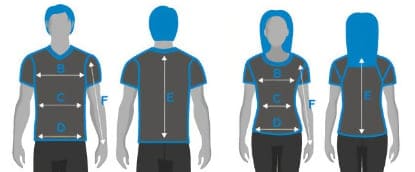
| Sizes(cm) | Child L | XS | S | M | L | XL | L-L | XL-L | 2XL | How to measure? |
|---|---|---|---|---|---|---|---|---|---|---|
| Height | 145-160 | 150-165 | 155-170 | 160-175 | 165-180 | 165-185 | 165-190 | A. Measure from the floor to the top of your head. | ||
| Chest Line | 65-80 | 75-85 | 80-90 | 85-95 | 90-100 | 95-110 | 100-115 | B. Measure horizontally around the fullest part of your chest, under the armpits. | ||
| Waist Line | 55-70 | 60-75 | 70-80 | 75-90 | 80-95 | 85-100 | 95-115 | C. Measure horizontally around your abdomen at the narrowest point. | ||
| Hip Line | 65-85 | 75-95 | 80-100 | 85-105 | 90-110 | 95-120 | 100-130 | D. Measure the circumference, from pelvic bone to pelvic bone, at the widest part of your hips. | ||
| Back Length | 35-50 | 40-55 | 45-60 | 47-65 | 50-67 | 55-70 | 60-75 | E. While standing upright, measure the distance between the lower neck and the tailbone. | ||
| Canister (Zip’In 1) | 50cc | 60cc | 60cc | 60cc | 60cc | 60cc | 100cc | The canister size must fit the airbag size. | ||
| Canister (Zip’In 2) | 50cc | 50cc | 60cc | 60cc | 60cc | 85cc | 85cc | The canister size must fit the airbag size. |
Frequently Asked Questions
It is important to choose the right size of your airbag for optimal protection. For this, we advise you follow our size chart. Hint: measuring your back is important and a good indication to finding the right size. Please note that this Airbag Safety Jacket should be worn over a Zip’In airbag. The size of the airbag and the outer must always be the same. (eg. A Zip’In airbag in size S must be combined with a compatible outer in size S.)
Yes, but you won’t be protected. The outer must be associated with a Zip’In 1 or 2 airbag lining to protect you.
All replacement canisters can be purchased from our canisters section found in the main menu.
All replacement lanyards can be purchased from our lanyards section, found in Equestrian Lanyards in the main menu.
Yes, as long as the airbag is in good condition with no holes or tears. It’s easy to do, you can reset the system in under 2 minutes, without sending your airbag system back to us. You simply need to replace the CO2 canister with a new one, available in our canisters section. Please read the manual and see the videos section on this page, showing how this is done.
No, once it is used you will need a replacement. All replacement canisters can be purchased from our canisters section found in the main menu.
All our airbag equestrian safety jackets systems come with a 2 year warranty. You can extend this if you register the product within 3 months of purchase and have it serviced by us at the end of the first two years. This will give you an additional two years of warranty.
- Bus, train, car:
No constraint. For electronic models, remember to turn off the vest when you take this type of transport with your vest.
- Plane :
You may encounter some difficulties with the security services regarding the CO2 canisters used to inflate the airbag. According to the regulations (IATA Regulations – see download), you are authorised to fly with 2 gas canisters (the volume must be less than 200cc), in the cabin or in the hold. Even if the regulations allow it, it is possible that the security service or the airline refuses to let you board with it. We strongly recommend that you print the “IATA Regulations” and show this document to the security service or the airline during the control if they ask for more explanations. In any case, it is the airport security service and the airline that will make the final decision whether or not to accept the airbag on board.
Often each airline will have their own advice pages online, it is worth printing these out also as supplementary documentation.


